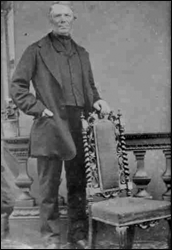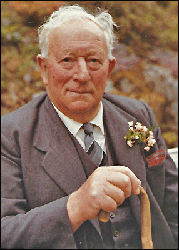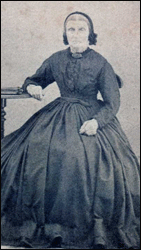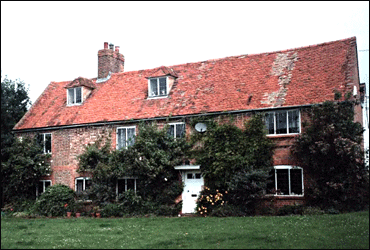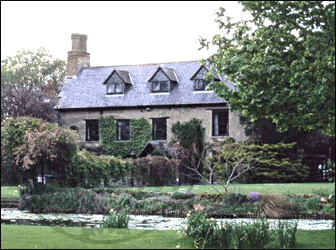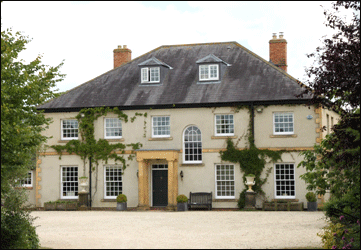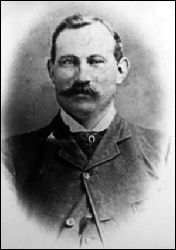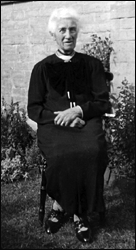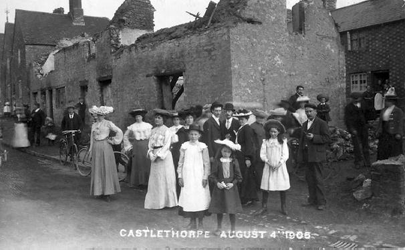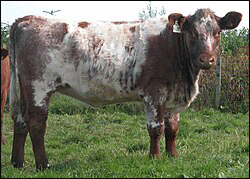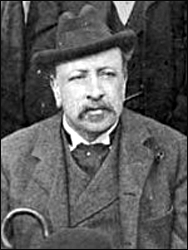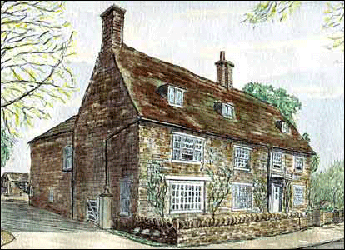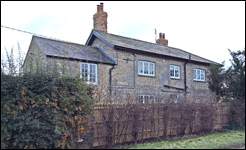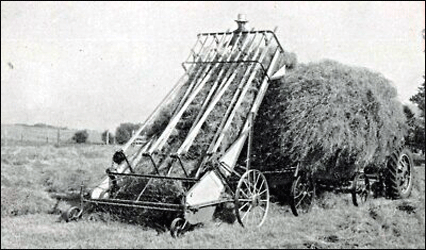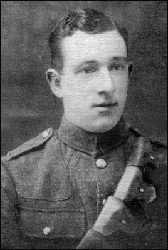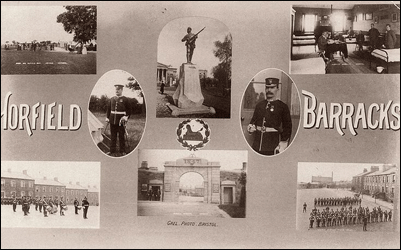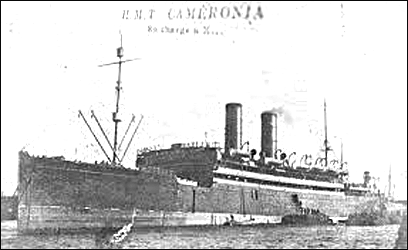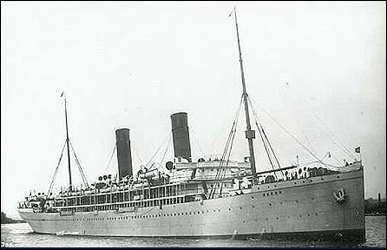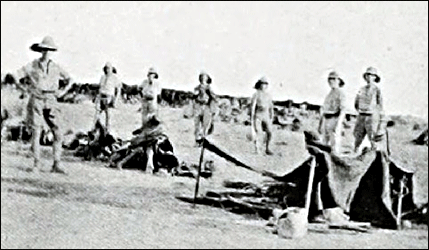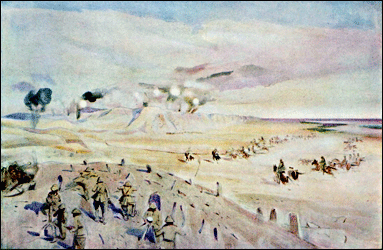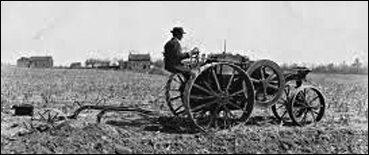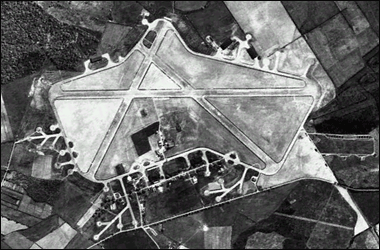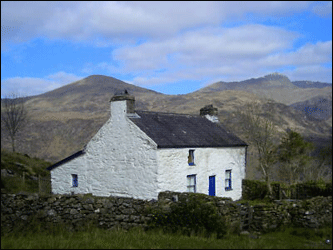|
Memories of Herbert Jones Markham
There once was a boy who lived in Waddeston near Aylesbury ,with his father George, and mother Hester/ Esther, also his sister Emma Pricilla, who was older than himself. Both the parents died early in life and George aged eight years was placed in a home at Aylesbury, until he was fourteen. His sister went out to service under the Guardians care.
Mr. Simmons of Buryfield [Berryfield] Farm near Aylesbury, asked George Markham, my grandfather, to work on his farm, which he did, doing general work until he was 18 years of age.
He then got a job with the old baker at Quainton as a delivery boy with a pony and cart, delivering groceries and helping to make the bread. The old man had lost his wife a year or two previously, and he now had a very capable young lady about 20 years of age a Miss Burnell, and she used to go to Aylesbury buying goods for the shop, she was very kind and helpful to the old man who seemed very lonely. She helped build up this business, was a keen buyer, a very good saleswoman, and knew the good payers.
One day in 1867 the old man died, and Miss. Burnell then married my grandfather, George Markham. I went to see this shop myself about 40 years ago, it stands on the hill in Quainton below the windmill.
Quainton village had its Annual Local Fair, with roundabouts and gypsy caravans. On one occasion, two of the ladies from the fair called at the shop to buy cheese and bread. My grandmother kept the cheese on the highest shelf and she fetched the steps to reach it down, and out of a hole in the far side, a mouse ran out and down her neck, and when she screamed my grandfather had to put his hand down, and held it by the legs until he could pull it out, much to the amusement of the two ladies waiting to be served.
Farming Families
1879, 1880, and 1881 were very wet years and corn rotted in the shocks, sheep died in hundreds of rot and fluke, many farmers went bankrupt and there were farms to let everywhere and at any price. Grandfather took as a tenant in about 1883 The Lower Street Farm Quainton at £1 per acre. It was very good land, house and buildings in the village, and my father went to live there with one of his sisters in the house, and worked for his father.
There were many children, who lived there. Hannah Markham 1864 (Mrs. Eynott,) Mary Anne Markham 1866 (Mrs. Wood), James Markham 1868 - 1906, George Markham 1870 who unfortunately died at 16 years of age. Elizabeth 1872, Esther Markham 1875-1916, Thomas Markham 1877-1951, Rose Markham 1878-1878, Frank Markham 1879, William Markham 1882-1885
Grandfather had then taken over a farm at Doddershall, in the next village, but I didn’t know very much about this venture, but grandfather had the chance of a very good farm at Godington. The Moat Farm, it was over 300 acres, and so he gave up Doddershall. Uncle Frank went there to live. My grandfather, and was now living down the street at Lower Street Farm. The Moat Farm was 330 acres of very good land, would produce much milk and fatten cows and heifers, what a chance for any man.
I understand that the present Mr. Markham’s father bought it for him, vacant possession, a lovely old stone gabled Monastery house where Monks once lived, it was surrounded by a moat.
Grandad [George] Markham, although he could not read or write much, was a very clever business man and a keen buyer of cattle, always ready for three teated heifers to milk at barren value. Grandad bought Godington Hall in 1897 and Uncle Tom farmed this on his own account. From 1891-1900.
With reference to my Grandad, in general he was a stern, strong but had very kind hearted man. His ten children 5 sons and 5 daughters were brought up to work in a very hard old-fashioned way. Money was scarce in those days and grandmother clothed this little army from the large amount of clothing stocks that she had brought from the shop.
Grandad was not a polished man, hard work and hard bargaining had been his lot so far in life but he always had a ready cash to pay when he bought stock, etc. His outfit when going to market at Aylesbury was a very heavy pair of boots a pair of new corduroy trousers with the usual flap down front, secured by a leather belt, a rather rough jacket and waistcoat with a neckerchief tie. In bad weather he wore an old fashioned overcoat and a cake sack round his shoulders fastened with a nail, and black Bill Hickok hat, similar to that worn by a parson today, and of course, his ash stick. He had no pride, and if he bought any stock said “I am George Markham from Quainton and I’ll pay you now.” His arrangements with cheques were misleading, his writing almost illegible. His answer to any seller, if in doubt “Come now to my house and I will pay you in cash.” He always carried a wash-leather bag containing 5 sovereigns and 10 half-sovereigns rolled in a tight bundle. In the years between 1898 – 1906, the year of my father’s death, his appearance vastly improved, at my father special request.
Landlords at that time had farms to let everywhere, and not many tenants willing to take on a farm or so. He, I should say my grandad, had farms for rent free the first year, what a help this was.
The Great Central Railway came through three of his farms from London the to the Midlands and drew three lots of compensation, one cut across Doddershall Farm to Quainton Road Station, the Lower Street Farm and then on through Godington Moat Farm.
The farmers of this district had a hell of a time with working labourers prowling about at night stealing and looting everywhere. Some of the farmers had guns and used to take turns letting these off at odd hours to scare the men off.
I was very young then and the story was hushed up, but my grandfather let his gun off after in the dark and wounded one man in the leg, whether this was only a rumour or really true I often wonder.
Later on my father drove to Godington one afternoon and stayed at the Moat Farm for the night it was about this time that my brother, Sidney, was born, but on coming down to breakfast at 8 am. the next morning, I said “Grandad, I’ve laid over.” Later on in the day we were going around this 330 acre farm in the little spring cart drawn by a pony. Grandad sat in the middle of the seat, Uncle Frank driving the pony and dad the other side. I was sitting on the floor of the cart in front and my brother was behind. When we got to the middle of the big field the pony tripped over an ant bank and fell. I landed on the pony and was by this time kicking and trying to get up so they all said that “I laid over again”.
|
|
|
|
James Markham
|
Ellen Markham nee Jones
|
In 1888 my father, James, married my Mother Miss. Ellen Jones of Field Farm, Marsh Gibbon near Bicester in Oxfordshire and my grandfather took a farm at Newton Longville called “Borough Farm”. Dad had therefore got a start, but he did not like the place at all, and began to look for pastures new, so he had one year in and one year out. He then took the Manor Farm Hanslope, about 140 acres and moved there in September in 1891, (at 23 years of age). My father drove an Oxfordshire wagon with their furniture on it from Newton Longville to Manor Farm Hanslope. The wagon was an old one and drawn by a team of three horses, £4 each, £12 the team. Mother drove an old pony in a very old fashioned trap with William, my eldest brother, in her arms just behind. William was two months old then. In 1894 my brother Arthur James was born. Mother and Father now had two sons, and I was born in 1895. Mother and Father worked like slaves at Manor Farm, Hanslope and was indeed a great credit to them both.
This stage of the story begins by me telling you about the members of my family with their ages.
My Father James Markham 38, my Mother Ellen Markham 44, my eldest brother William David almost 15, Arthur James 12, myself Herbert Jones 10, George Ernest died from scarlet fever aged 23 months, buried in Castlethorpe Churchyard 15 February 1900. Nellie Louise, my only sister 4, Sidney Frank 2.
With reference to my Mother, she was a deeply religious woman, attending the Chapel regularly, and we boys were sent to Sunday school too, so that no unnecessary work or business was permitted on that day, she not or only read her Bible each day, but gave each of us children a Bible of our own, and alcoholic liquor to be taken only in very strict moderation.
From 1895 – 1907 we boys walked together to the school that Castlethorpe and I well remember being sent home from school when the South African War ended, the African War Chiefs were Generals De Wit, Kruzer and Crongie, and our own Lord French, Lord Roberts and Lord Kitchener, the latter was drowned in 1916 when H.M. ship Hampshire sank then in the English Channel. Following the peace in South Africa, Queen Victoria died at a very ripe old age, and the following June saw the Coronation of King Edward the VII, with great celebrations at Castlethorpe. A carnival in Castle Field, and brother, William, was made up to represent Fred Archer the jockey on Jack Mother’s pony, Alfred Walker, Dad’s drover leading the pony.
|
|
|
The Fire at Castlethorpe: 1905
|
We boys went home from school at mid-day, having broken up for the Summer term holidays. At about 2.30 p.m. as we were playing in the farm Manor Farm Hanslope being only a mile from the village, two employees working near by saw big volumes of smoke reaching high in the air from the village. We went to see what was the matter, nine houses had caught fire, and unfortunately it was a very windy day, some of the furniture had been removed in time, but most of the effects were lost. In one case, the people had been out shopping at Wolverton, and they only had just the clothes they stood up in. Water was scarce, they laid a pipe to the river a mile away, this of course took time. The Railway crosses through Castlethorpe, and some boys standing on the girder bridge saw a spark blow over on to a thached barn, from the front street to the back street all burnt in about two hours, the wind was strong and the time so short. I was only 9 years old at the time. The Parish Council opened up two schools for these unfortunate people and the railway supplied tarpaulins to cover the furniture.
---------------------------------
1905
Now Dad had business commitments which took some time to wind up, for instance in 1905 he was asked by his father-in-law, a very old man, to go and see Uncle John, Mother’s eldest brother. It was May and nearly rent day and he had received help from his father in former years, and wanted help from somewhere, and Dad had to weigh the case up quickly. You have only a very small farm of 56 acres, John, and your rent is £100 a year. I will pay you £50 now and take Hill Field for one year, you will have had one year’s rent in advance. I will then send you 12 two year old shorthorn heifers, most Strawberry Roan, and later to finish their lactation and a four year old working horse. Remember, John, you must make great changes to make a go of it. I have been a very good friend to you. In 1906 the twelve heifers came home to Manor Farm, Hanslope, down calving and the cows came too as they calved. Dad paid for the hay consumed during the winter. This did not seem to help John as it should have done, he was no business man, and so Dad helped him one more year in the same way. In May 1907 these cattle came home to Manor Farm, Castlethorpe, as Dad had died in 1906. Uncle John came to see Mother and talked for some while, although we boys didn’t know what happened and John actually died soon after this.
When referring to Strawberry Roan my mind and memory goes back to the late Mr. A. G. Street with his book entitled Strawberry Roans. Dad had a very good customer from Campwell? Grove near London, who came once a fortnight wanting about six good Strawberry Roan dairy cows with good bags. Dad bought Strawberry Roan heifers to lay with a bull, so this way he had by him cows calving down, and was still looking to buy cows to suit this gentleman at this time.
I remember from we boys went with Dad during a holidays visiting farms buying cattle, and many farmers called in the evenings to look at cattle for purchasing.
In 1905 also one tenant took fifty black-faced ewes and this tenant discussed this venture with Dad, it was a breeding flock.
1. Should he pay nothing, keep the ewes ten months free until August 1st and have half the lamb money.
2. Pay 25% down and the rest on June 15th, of course a good interest on the money.
Dad recommended the 2nd terms and said ‘I will take them at a further profit to you next year:
1906 When June came Dad paid as promised for the ewes and lambs and held a legal receipt for the same. Dad having died in the meantime, Grandad told Mother ‘I will take the ewes and lambs to Godington and then they will not be any further trouble to you.
|
|
|
James Markham 11 March 1868 – 12 July 1906
|
We boys knew only too well how very ill Dad was, about four days a week a parcel of fish came to Castlethorpe Station from Grimsby, a special kind for a person on a diet, he also was given breast of pheasant, two brought each Saturday when in season, sometimes tripe, specially prepared by Mother.
He always rode in a rubber wheeled gig or trap, most of the horse drawn traps had iron wheels, this care, taken to prevent shaking him in transport. Dad was under the care of the most noted Dr. of the district from the small town, near Stony Stratford. The Doctor persuaded him to have an Xray, this he did and it revealed a large ulcer. Mother went with him to London to see a Specialist, a Mr. White, he hoped to go to Kent the following day to a lamb sale, but the specialist advised him to return home at once to have an immediate operation. Mr. White came down for this operation, bringing a trained nurse with him. Dad only lived about one week after this when haemorrhage set in, this caused his death, he had been a very good husband and father to us children and was sadly missed by all.
It was the 12th of July, 1906 When my Mother wrote in her diary ‘My darling husband entered into rest, may his sole be blest, leaving me his widow with five children to care for, but he had a asked previous day to see all of us children, he looked very ill, but I spoke to him at 5pm.
My father was a tenant farmer of Manor Farm, Hanslope, where we were living at this time. I well remember his funeral July 17th, and he was buried at Castlethorpe Church, no motor cars in those days, there were five pairs of jet black horses, two drawing the hearse, Mother and we three boys in the first carriage, relatives following. My father’s horse, that had taken him many miles on business, and mother’s pony, Jacky, bringing the employees in his gig and Governess cart.
He was a big businessman and there was a very big crowd present. My father had been a well known cattle dealer and farmer grazier. Manor Farm [Hanslope] was about 140 acres, and Mother helped considerably in his affair both on the farm, keeping his books, and working in the home as well.
After his death, my brother, William, left school and helped Mother. Father was a well built smart man, mixing continually with important business men, under these circumstances he didn’t work manually on the farm, but sold dairy cows in numbers to go to London sheds where they were milked.
In the Spring he sold hundreds of young barren cows to the Northamptonshire graziers, and store cattle also. I remember holding cattle with my brothers in Northampton Market. In 1904, I was only eight years of age at the time. Father bought many barren cows at Kent in the Spring, and Kent lambs in August, these he sold locally. He had a keen interest in horses and sold many to work on London streets, he was a good judge of horses and cattle, saying when selling a horse, ‘warranted in all kinds of harness, pass any traffic, sound in wind and limb’.
Mother had been a very great help to my Father, she was a good Mother and a really good practical farmer and business lady, with a strong nerve to drive a good horse in the gig when father was selling one. His death certainly broke up a good business relationship between man and wife. Everything was left to my Mother in the Will she was also sole Executor.
After the funeral the books of the records were opened, details of an animal had been entered, irrespective of where they were grazing. Some animals had been sold before Mother could get them home from Lower Leckhampstead, and other farms. There were some at Thornton Park 70 acres he had taken temporarily as a grazing tenant, and many other smaller acres of land. Father had 3 and 4 year olds young horses, lent out to work, and young cows lent for three months to milk, until they were dry. All these animals were collected and brought home in due course.
Mother had to go to Court at this time, many cattle had been sold illegally by the farmers who were grazing them. Two cows carrying their second calf were lent to a farmer at Lower Leckhampstead Farm to milk out before going dry. One horse 3½ years old working for its living and cattle grazing at so much a week. This account was settled monthly, when my Mother William and Alfred Walker my father’s drover went to this farm to pay the rent due, there were two cows missing. The Police were called in, the strawberry roan in calf shorthorn heifer was traced to a Public House at Fenny Stratford, the buyer stated that he had paid for it, and I am not willing to part with the heifer without the cash. The Police informed him that this being so it is stolen property and you must not move it. Mother sued in the County Court and Mother had the possession of her heifer and the new calf. Before father died, he was selling ewes and lambs in April from a Mr. Dudley of Hartwell. Buyer and seller, two different prices, but said Mr. Dudley, will accept your price if you will take out a Life Policy. Although father already had one, he was persuaded to take out a second one, so when father died, Mother had two Insurance Policies to collect.
Prices for stock and goods in 1906 were as follows:
A fairly good bagged third calf dairy cow shorthorn £25 - £28.
A five or six year old shire Gelding sound in wind and limb £58 - £62.
Black faced Oxfordshire down Ewes for breeding in August £2 10s. (full mouthed)
Hay in the rick for sale to London buyers, loose in the rick £3 per ton.
The buyer to cut and press it for transport and the seller to put it on rail.
Milk was sold by the barn gallon, and as far as I can remember 17 pints to the gallon was a barn gallon 1s. 5d.
Eggs averaged 1d. each
Wild rabbit, undamaged skin 1/-d
Average wage for a six day week agricultural worker 18/-d and if he fed cattle on Sunday, house and garden free.
|
|
|
Squire Watts – The Eviction
|
The date now July 20th. Robert Waring, the herdsman, and leading hand on the farm, had been busy helping with the hay but had just finished this when the Landlord, Squire Watts, of Hanslope Park, called to see Mother, and although sympathising with her over the death of her husband stated that my father had been the tenant of Manor Farm, she would be expected to vacate the farm at a quarter date to be fixed later, he couldn’t see his way clear to accept her as the new tenant. She replied that as she had five children to look after, she was so upset it would be impossible for her to look for any other place at present. This man was shot dead whilst walking home from Hanslope from Hanslope Church six years later by his gamekeeper.
Manor Farm, Castlethorpe, was coming to let April 1907 and Mother applied for it to an Agent in Cambridge, it consisted of 525 acres, and when we returned home from school Mother explained to us as she could not remain in our old home, we should have to move. Soon after Mother had applied to the Cambridge Agent for Castlethorpe Manor Farm, a letter came from ‘Carter’, a large envelope, and she thinking it had come from a seed firm put it on one side until dinner time. She then had a very pleasant surprise, it was referring to Castlethorpe Farm, and suggesting that if still interested would she call at the office in Cambridge the following day, and after sending a telegram to her brother-in-law asking him to meet her at Bletchley Junction, Mother took William with her and stayed the night at Cambridge. Calling at the Agents the following morning, they were a little disappointed, a gentleman farmer from Buckingham came out of the office, and Mother thought that they had lost the farm, but the Agent informed them that the Landlord, a Marquis, wishes him to interview Mother and to tell her that he was in a position to offer her Manor Farm, Castlethorpe, 420 acres, annual rent £600. This she accepted and signed the Agreement, correct one to follow shortly. This was now the beginning of September, and a week after her return from Cambridge she called on Squire Watts of Hanslope who was angry with her for taking another farm, evidently hoping to an agreement over his own farm, and she requested that he would release her within 6 months. Not hearing from him again at this time, Mother then let for summer grazing. The first field was bought in by my uncle for 31/6d. an acre, this being 37 acres front field of the House. When Manor Farm, Hanslope was let, the new tenant asked for this field to mow for hay and he had it.
At the previous Christmas, Hanslope Farm was overloaded with strong cattle and young 3 and 4 year old working horses awaiting to go to Castlethorpe in the Spring.
To claim ownership of the stock, Mother had to go through cheque books and receipts, these in some cases had to be produced before a judge.
Manor Farm, Hanslope, had one big, arable field 32 acres. Mother shewed great interest in this, being very particular when the corn drill was used, and to be there when Robert set this drill in line for work, corn drills nine inches apart, Winter beans 24 inches apart and mangel-wurzel 27 inches apart, the latter drill quite different with high ridges.
Mother realized that she had much to learn, Tenants’ rights, Valuations for which she had only slight knowledge. She bought books on Agricultural Law, also the Volkier Table giving Manurial Values. She read herself, and instructed us boys on hay grown on the farm, Manurial Value (no claim) Hay bought on the last year and consumed 25% Spring Valuation Bombay cotton cake 1906 £4 a ton. Linseed cake perhaps £8. These items were worked out and a man leaving the farm was entitled to compensation of 20% of the Market Value cost.
February 2nd, 1907, Mother was entitled to enter Manor Farm, Castlethorpe to work and plant about 50% of the arable land, only for this year’s harvest. There should be about 110 acres arable, about 25 acres of it was sown in wheat in October 1906, and 10 acres of beans, and 10 acres of young clover. Now she had to work and plan how she wanted to crop the remaining 60 acres. She had drill planted two lots of Spring oats, say 25 acres in February, and ten acres of Barley April 1st, and 8 acres of Spring beans. This left a few acres of mangelwurzel and some acres of bare Summer fallow.
On Saturday, April 6th, Mother, Robert Waring and we three boys came to Castlethorpe with 45 strong cattle, in-calf cows and heifers, and all the young cattle, the remaining cattle on the following Monday, Tuesday and Wednesday, and we finally settled in the house on Thursday, April 11th, what a wonderful Mother we had.
Now this settled a widow and her five children in a home and farm of 420 acres, and a chance for us all to do our best. Mother had a milking herd of 50 Shorthorn young milking cows, 11 working shire horses, and total flock of 200 ewes and their lambs.
From 1907-1914 we boys, now much older, were able to do all kinds of work on the farm. Farming was on the upward grade, the country having forgotten the South African War, things generally seemed peaceful and successful. I remember after Harvest seeing three teams of horses going out to plough and to work on the arable land every morning at 8.15 a.m. in the season, two single teams of three horses in a line walking up the furrow, and a four horse team two fastest before and two behind, and another four in a square drawing a double furrow plough, three ploughmen with three boys to drive the horses in the team, no tractors in those days.
|
1908
|
|
|
|
Field Farm Marsh Gibbon
|
David Jones 30 January 1832 – 25 July 1908
&
Louisa Godfrey Jones nee Chaundy Bap. 27 January 1831 – 24 February 1908
About this time Grandmother Jones, Mother’s Mother died aged 77 years and Grandad never really recovered after this and died only a few weeks later. They lived together at Marsh Fields Farm for 50 years, it was bought for them by Grandad’s Father when they were married, ⅓ payment down and ⅔ on mortgage, and it took them fifty years to pay for it. Mother was asked after the Will was read would she act as Executor but she declined saying as a widow with five children she didn’t want the responsibility. After further family talk between her two married sisters, her two bachelor brothers and the Lawyer, she agreed to act with the help of her brother-in-law.
Mother told her brothers she would expect them to do a better job and to pull the farm out of its present very neglected state, we boys at Castlethorpe helping all we could by driving the horses in the ploughing season, milking the cows and feeding also the small calves.
---------------------------------
Each year we had three or four year old colts to bring into the plough team, the first year as they only worked in chains and after this in shafts and chains. Mother always had about three or four five and six year old town working horses for sale in June, a good six year old town Gelding was worth £60 - £64 at that time. We did arrange for 12 heifers to calve down in September ready to milk in the dairy herd and added heifers at other times of the year. Mother had about 10 – 12 third and fourth calved cows to sell in October. We generally thrashed fifty acres of wheat from stacks in the rickyard in December, this again, with a rent day in view. We boys did not get much pocket money, only a few shillings when we went to market for a dinner. We also had a black-faced flock of non registered Oxford down ewes, about 100 mostly kept on the grassland, and sold the lambs when and fat except the draft of ewe lambs for breeding. We did not breed any foals bought 3 or 4 at the Sales in the Autumn. 1911
This was a very, very dry year for the farmers, the pastures dry and brown. Mother had learned how to grow Linseed as we used to buy this for rearing calves, when boiled. The young calf stayed with it’s mother for a week and from then it had to be taught to drink new milk from the bucket, from a month old we began boiled linseed, until they had all linseed until 3-4 months old.
During this period 1907 – 1912 farming generally looked up, and prices began to rise on the World’s Market. Young men were now more eager to go into farming and to take a farm to rent. I wish to point out that from 1900 – 1915 85% of the cattle were Dairy Shorthorn 10% were Herefords and Welsh Blacks imported here by the Midland graziers for fattening in the good summer pastures, the remaining few were odd breeds and cross breeds. At this stage in the book I wish to say, Cereals imported from abroad had about double that in price and millers and compound cattle feed manufacturers have passed all these costs on to the farmers. Milk has not been put up in price to the producer and is losing money for to the producer, and beef cattle are on the same footing, and a fat bullock loses the cost of the last month of feeding. Pig producers are the worst hit of all, in fact, farmers are asking the Government “Do you wish us to kill the baby pigs when born” we can’t afford to buy feed to feed them, and are expecting an answer to this query shortly. Common Market countries are giving their exporters £3 - £4 a pig subsidy in bacon form to undercut our already be low cost Market.
Reverting back to Mother and the farm, in those days hay was pitched and loaded on a waggon by a fork. The first hay loader we had was a McCormick 1909, and he looked on at the centre back of the hay cart or waggon. William drove a chain horse in front of the horse and cart, and the man on the top loaded the hay. We also had a frame bolted and fitted to them with strong sides. Mother bought a swath turner in 1908 and the side delivery rake at the same time, this putting hay into rows for the hay loader. In the Rick yard we had a hay elevator to take the hay to the top of the rick. Pick-up hay balers came in war time 1915- 1919 which was a farmer’s greatest asset. Hay grown on the ploughing (one year lay) we then had 100 acres of hay to gather. There were no manure spreaders in those days, the manure was filled on to farm carts with a tine fork, the cart would partly tip, and the manure was left in rows of heaps in the stubble after harvest, it was spread by hand and ploughed under. We also sheared all sheep with hand shears, before machines came on the farms. Wheat, Oats and Barley was cut with a binder, but beans were cut with a sailor, and left untied in sheaf size bunches to be tied by hand. We were taught all these tasks before World War 1 being declared. Mother had two Army reservists called up after a few days, for the Territorial Army, and naturally as more men enlisted the harder we had to work. At the end of 1915 two of our young married men joined up, one the horse keeper, and the other one had helped considerably with the cows. It was at this stage that Lord Kitchener’s scheme came into being, we had to go when required. Mother then decided to give up selling milk with the dairy herd, most of the cows when they had calved was sold. Most of the cows retained were suckled and we turned to calf rearing. My brother William was called up early in 1916 and he joined R.G.A. There was quite a talk in the district, Mother had three sons and not one in the Army. Many of the boys of the village had already been killed. I was called up in March 1916, and mother applied for an extension of six months for me to help her on the farm and this was granted as 8 of her employees had all left her to join the Forces.
I well remember very early in 1915 going into the Cattle Market bar at Northampton Market and sitting back eating a bun with a cup of tea, it was about 10.30 a.m. There was some country farmers standing by the bar all drinking from glasses, looking very clean and tidy, and prosperous. Amongst this party was a Mr. Everit and through the door came a soldier, straight from the trenches in France, and he went straight up to Mr. Everit, and Mr. Everit looked at him. Mr. Everit said ‘My Son, My Son’ and he fell into his son’s arms, Father and son embrace together. The son poor fellow, was very much in mud and look worn out.
|
|
 |
|
Herbert Jones Markham 27487
|
13th Hussars Badge
|
On May 1st, I also left and joined the Cavalry of the Line.
There were many bands playing in the streets at this time, and it is thought that several of the men were really Germans spies.
English Officers were coming to the farm to buy horses, thickset trotting horses, Cavalry chargers, they had the power to commandeer if they wished, but when they came to Manor Farm my brother sold them four horses, two of each class, and the price paid for these was fair.
Recruiting offices were opened in every town, and a Mr. Charlie Chaplin appeared at this time with his recruiting song, late 1914 early 1915.
When the sun shines bright on Charlie Chaplin
and his boots want blacking because they’re cracking
his baggy little trousers, they want mending
before they send him to the Dardanelles.
Canadian troops had at this time been over in England for some time, and American troops too were appearing in England, they having come into the war on our side. There was very heavy fighting in France and Belgium with very heavy losses. Farmers were to provide more food with a very small labour force. A gentleman called to see Mother asking her to grow still more, and when she told him how very short of labour she was, I was granted an appeal for another 6 months to help her with work on the farm. Mother then received a notice from her Landlord’s Agent to leave Manor Farm, he was angry because she still had two sons at home, instead of joining the Army when I had enlisted, the Landlord withdrew the notice.
I joined the Cavalry because I had worked with the English Officers who were purchasing horses for the war effort from the farm. As I was at the recruiting table, another small man was waiting to be sworn in, ‘Why do you wish to join the Cavalry?’ said the officer, and which side of the horses do you mount?. In Bradford where I come from, we always get on the outside (loud laughter).
The pay was 1/- and 1d. a day. We bank 1d. a day for you and 1d. from the Government, but this 2d. Is banked unpaid on demobilisation, as I served in the Army for three years it amounted to £4 11s. 3d.
I was given a Railway voucher and had to report at Horfield Barracks Bristol. The sentry sent me to the Guard room, and the sergeant on duty took my papers, and I was given a bed for the night, six of us were taken to the stores next morning and given full clothing equipment for, after a few days eight of us went with a sergeant in charge to Longmoor Camp in Hampshire to the 14th Cavalry regiment, to be trained wearing a 15th Hussars badge and as we left each man received a pay of 5/-d.
We were taken to married quarters, which were then empty, and after going to the Mess room for a meal found that we had all been robbed of our precious possessions.
The following morning we heard reveille by many trumpeters, and we stood waiting at the door for our orders. The Sergeant told us where to go for replacements of our stolen property at The Quarter Master Stores. We were then inoculated in the arm and had no duties for 48 hours. With one other I then was placed in the 4th troop D. Squadron. The wet canteen closes at 9.15 p.m. and light out sounded at 9.30 p.m. by the buglers.
May 1st 1916. I am now Trooper H. J. Markham 27487. As the new recruit my daily duties were as follows: roll call 6.45 a.m. and with others we marched off with 4th troop D. Squadron to the stables to feed, water and attend to our horses, each troupe had three sections, right, left and centre. The regiment consists of four squadrons, with four troops to a squadron, A. B. C. D., in D. Squadron 140 men, a Leader, Captain and 4 Lieutenants, all commissioned officers and including N.C.C.s., A Sargeant Major, four troop sergeants, usually a full Corporal and two Lance Corporals. Breakfast consisted of basin of tea, Buglars Glue for porridge and bread with bacon. After this, physical exercises until 10.45 a.m., morning stables and bridles cleaned and soldiers coming from Squadron drill.
I worked under a trained soldier cleaning his horse and harness. One troop had 40 horses in a stable. For a dinner, Army stew, potatoes, tea in a basin and Army Plum Duff. Recruits then changed to riding pants, puttees, best boots, well cleaned brass buttons and badges, and we were made to shave once a day. We then went on parade, and after inspection we were given general knowledge of the Army. Every recruit was expected to be on Church Parade on Sundays.
After a month’s training we were told to parade with the horses and blanket fastened by a buckle, and after dinner when on the square we had to wear spurs and a bandolier and carrying sword, rifle and bayonet, my pay always 1/- a day at this time.
At my Mother’s request the C.O. granted me a month’s Harvest leave, during this time I helped Mother and Arthur as much as possible, things were very difficult with only three old men left as well on the farm. The Agricultural Officer thought I should be released, but his suggestion was turned down. Three Grade III men who didn’t really want farm work were released, but as I was an A.1. soldier my Mother’s plea was refused.
With others we moved to Fermoy Barracks in South Ireland for three months and then to Aldershot. In March a draft of us started for Mesopotamia, after having seven days embarkation leave.
April 3rd 1917. 248 men with 4 officers left by train to Southampton, arriving at night, we embarked on a Cross Channel Steamer. The following morning we woke up in Le Havre and boarding a train heading south to Marseilles, and again embarked on a big ship The Cameronia at Marseilles leaving there with over 2,000 aboard, and on Sunday, April 15th we passed through the Straits of Messina. Just as we finished tea, we had a hell of a bump, the ship had been torpedoed, I could not move far for the crowd, but as a Destroyer drew to the side of the ship, I jumped with others to the deck below. The Cameronia sank in 20 minutes, with 180 men reported missing. We were so packed together on the destroyer that we were unable to lie down and everyone, hungry, thirsty and depressed. At 6 am. an old sailor brought a bucket full of tea and a basin, and each man to have a little, as more tea was brought forward. After 16 hours sailing we reached Malta, and an elderly Field Marshal came forward to greet us, Lord Methuen, the Governor of Malta. He was lame, he had lost the limb in the South African War.
Here we were numbered of into lots, 24 men in each lot and a camp orderly brought each man a blanket, and also some food, good Army stew, bread, basins and spoons, one spoon for 4 men! And tea for each man followed.
Biscuits and cheese were dropped by plane, and towels were left also for us in the wash-house. On Sunday following, one large Church Parade, me with only shirts, spine pads and shorts, no boots or socks and a free shave from the local barber. Morning Service held in the Australian Hall, all singing the wonderful hymn ‘Eternal Father, strong to save’, and the sermon on Jonah in the belly of the whale. Now thank we all our God.
|
|
|
S.S. Saxon
From 1917 on, she was used full-time for trooping, primarily in the Mediterranean, ferrying troops between Alexandria and Marseilles.
|
After a few days respite, we re-embarked on the troopship ‘The Saxon’ and pushed on further out to sea, with two destroyers to escort us, after one day’s sailing we had a second shot from a submarine, but fortunately she missed, and our next port of call was Alexandria in Egypt. We disembarked there are went to a rest camp, we here received a paybook and payment of 5/- to each man, each was given a pair of boots, socks, sun helmet, I then passed a man with a black spot on his neck “Jack”, I said “Is that you?” Yes! It was Jack Baker, a man from Milton Keynes, very near my own home town. He had been in Palestine, near Gazar for nearly two years and had been sent here for a rest, in civilian life he had been keen on horse jumping in Show rings.
After a few days’ rest we boarded a train at Alexandria, and arrived later at Port Suez, a ship canal of 100 miles, and later passed the Gulf of Akabar. We passed through the two great rocks called “The Gates of Hell” and then farther on 50 – 80 miles we passed 12 big rocks standing in line “The Twelve Apostles” they are called, we then had soon reached Aden. We waited for ships to convey us in convoy to Bombay in India. We disembarked here and went by train to Meerut a hill station. We stayed here in big stones stations, buildings like churches, for three months. Here we received our No. 1 field service kit ready for the firing line. There was a farm here, with water buffaloes, these were milked twice daily like cows. This supplied our military station. An Englishman, Mr. Peechay, was in charge of the Indians who worked on this farm.
The beer came from Dyers of Delhi, in large hogs heads, drawn by 4 big white bullocks to the Canteen.
Meerut was a peacetime station, here we were expected to keep ourselves smart, clean and tidy, but were would not allowed to visit Delhi.
A troop of horses were kept there and thirty of us at a time could go out on mounted parades and drill, and we could visit the Library in the Camp during the heat of the day.
On August 1st a draft of sixty men were detailed to the regiment in Mesopotamia, the Fighting Line. We took the train to Bombay, a day and a half’s journey, to then embark on the troop ship Shushan, after resting for two days. On our way up to Basra, in the Persian Gulf we had the experience of some rough monsoons. Having which certainly made the ship rock and roll. Having arrived at Basra, we were stationed at Asha Barracks for a few days waiting for a big barge to take us up the Tigress, we boarded a large barge early one morning and reached our first stop, Kurna, a place for Market Gardening, and irrigating the water from the Tigress. With this form of transport we had to tie our barge up at night, only travelling by day, we had two Indians with poles, one each side to keep the barge from getting stuck at the side of the river bank. This made slow progress, but there was only a limited supply of motor transport at this time, reaching after only a few days the place where General Townsend had surrendered to the Turks, only a year or so before, only an unimportant small place with very little going on. A bit North, the pipe line runs through from the Persian Oil Wells to the Mediterranean Port, for shipment to England, this had been stopped by the Turks when they were in control, and the force fighting there were trying to open this pipeline again.
Shushan, armed launch, stern-wheeler. Armed with 2-3pdr, later 1-12pdr/1-3pdr.In service from 3.3.15 in Persian Gulf area. Battle Honour (and link to despatches, casualties, awards) Mesopotamia 1915.
In the course of a day or two we reached Hinade, our base for the 7th Cavalry Brigade. The following morning, Lieutenant Welstead, the Officer in charge, came to meet us with twenty men leading sixty horses, a horse for every man to ride the 25 miles journey to Chaldia Camp, ten miles north of Bagdad. Our kit bags were taken from the barge to Chaldia Camp by 7 carts with 2 mules in double harness and Indian drivers. The soldiers there helped with the horses and gave a warm welcome to their new comrades. As a new draft, we were marched to the headquarters of the Regiment, we were then detailed off to each of four squadrons, 15 men to each A.B.C.D. I was sent to D. troop. The 6th Cavalry Brigade had been camping there since May to shelter in this date plantation from the extreme heat.
There were three cavalry regiments, the 13th Hussars were English, two Indian Lancer Regiment (the 13th Lancers and the 14th Jodhpur Lancers). During the summer, one or other of these regiment had been out on reconnaissance duty, but no Turks were reported locally. We were now definitely on active service and we were well aware of the very awkward water situation. Although near the River Tigress, it was dangerous to use this, the banks very steep, we had to take the horses for many miles to a crossing to drink, to wash and to get water to use. We were expected to collect a water proof bag called a Shargol to take back full of water morning and evening to the camp, this we handed over to our superiors for camp use. We cleaned the horse lines up twice a day, we had no tools of any sort, we had to collect the manure by hand, and many, many mornings we had nowhere and nothing to wash our hands in, many had the Itch and Scabies. Our tents were over our dugouts, and we had many lodgers crawling on our shirts. We often had air raids from the Turks, we used our stirrup irons tied on our head collars, we stood in a deep trench holding our horses for fear of a stampede. When we complained frequently we had a trip to a bath arrangement in Bagdad and were told that we might be moving on any day now, this is active service. We usually got a mail out from England once a week, and a light meal in the morning called Tiffin, consisting mainly of fruit, dates, lemons, bananas and oranges. The evening meal, our dinner, we sat out of the bivouac to eat it. The middle of September meant a big move. The new draft were ordered to pack saddles.
My troop sergeant gave me the necessary kit and I packed ready for the fighting line, beginning with a corn sack which is long shaped like a sausage about 2ft 4ins and 1ft 4ins each side and a slit in the middle to fill it. You then twist each end so that the middle is tight enough, and so will not spill the corn. This is strapped on the front arch of the saddle which is then under your hands when riding. Roll your warm great coat into a complete roll, that is then strapped over the top of the corn sack. On the near side, the side one mounts, is a small leather sheaf, a case to hold two horse shoes. On this case is a strong leather D into which the sword fits, and hangs down when the horse and man are travelling along. At the rear of the camp there was a place, an export department under the care of Sergeant Carnegie, an Irish man, he had been given three stripes on his arm to take on his job, which he did so well that he was given eventually the Meritorious Medal. With an assistant they dug a trench about 12 yards long 15 inches wide and 15 inches deep, this was in continuous use, these two men were constantly throwing soil and disinfectant over to sweeten the area, and kept paper corn sacks for use, he was known as Rear Admiral Lord Carnegie. We catered for these two men, when we were on the move, a horse kept for each of them, the assistant lead a pack horse with all the tools needed. They left camp with the rear guard, but when we halted every hour for ten minutes, they passed by us and were always first in the new camp, and would seek out the officer in charge to make new arrangement for 600 soldiers.
The opposite side of our horses we carried a rifle, leather long case called a bucket, where the rifle is carried, and from the front of the saddle is a strap fastening carrying 90 rounds of ball ammunition.
Around the rifle bucket are shackles to fasten the horse down at night. Now the soldier has a field dressing inside his coat on the one side and an iron ration in the other side, and his pay book and his will made out in his tunic. His haversack on one shoulder, and his bandolier full of ammunition on the other, the bayonet belt round his wrist and bayonet hanging from it. He wears a toupie with a puggery fitted on a helmet shade hanging to protect his neck. He always carries a spine pad whether in use or not, he has two discs, around his wrist (one) and the other on his braces, these give his regimental number and professed religion. He keeps his water bottle under his arm and his mess tin strapped on to his rifle bucket, his towel, knife, fork and spoon in his haversack round one of his shoulders. On the march, or fighting, he has no change of washing, all this is in his kit bag, this following behind in transport. A horse blanket goes on first, then a mackintosh ground sheet, then the soldiers blanket, all this goes on under the saddle. Soldiers pay: 1s. 1d. per day.
We were travelling across the desert to strike a small river called the Zab and there was a smaller town higher up called the Lesser Zab. To see this regiment of 700 men, with aeroplanes, our own dropping orders from the sky seemed to me a wonderful sight. We passed convoys of Arabs, their donkeys loaded with produce, dates, etc. for some Eastern market town. We saw packs of wolves disappearing in front, also jackals, foxes and all kinds of birds of prey, and on one occasion we were in contact with several types of men, these are our Intelligence Officers recognized, their chief was Lawrence of Arabia.
The following morning, 600 mounted men followed by odd units and the 13th Patiala Lancers moved out, the Patiala Lancers were four miles on our right, and the 14th Jodhpur Lancers on our left, what a sight. Planes had been viewing the position and on their word of command we had to act. The Hemel Jemel hills or mountains were about 20 miles in front of us and we had seen them standing high when marching the day before. The idea was to take this little town of Lesser Zab as soon as we arrived, but two regiments of Lancers were to bypass far out to cut off retreating Turks. We approach this town with little difficulty them or opposition, there were very few remaining Turks, about 100, these we took as prisoners most of their forces had retreated into the hills, ten miles away.
General Allenby was engaged in fighting at Palestine, the main Turkish troops had gone there. We sent a detachment of troops with our 100 Turkish prisoners to Bagdad. We were harassed continually by the Turks in the hills. Air bombing was our greatest help, we were able to know by this where to advance without too great losses in men, horses and materials. Our line of communication was 30 – 40 miles away from Chaldar Camp, our base, our iron rations were coming through our supply column, we kept as clean as possible with the sand, using it in handfuls. We were always on the alert, waiting for orders dropped by planes, and at this time while holding a position 5 – 6 miles from the town, and it was necessary to get to the town for food to supplement our monotonous diet. Only a very limited number of men in the Brigade could speak Arabic, and the troop sergeant asked me to volunteer to help in this way, and after being offered a bodyguard, I went to the butcher for liver and sheeps fry at the slaughter house. News came through that there was to be a beer ration that evening so the boys that owned the Crown and Anchor boar came to see me. I told them that they would have to pay 12 annas per bottle, no money, no beer, and only one bottle to each man, the spare one goes to the Sergeants. The orderly Sergeant with 4 men went to meet this valuable consignment, it became in a crate shaped like a coffin on the men’s shoulders and placed down very carefully. The men enjoyed the evening, joining in “Old soldiers never die, they only fade away”.
We had two squadrons one on the left and one on the right, patrolling between the town and the Hemel Jemel hills every day, and we were firing at each other constantly. My squadron went out every other day, but we were not allowed to leave the camp and our horses, put a Y.M.C.A. tent was erected, so we had somewhere to go when off duty, and also religious services were held from time to time. We could also write letters, and tea and buns were also sold there. The 7th Hussars were moving in that day from India to take our place, and we then had a march of 40 miles across the sandy plains towards the River Tigress. We crossed 7 streams and lost men and horses by drowning. I will remember Captain Godfrey saying to me “Markham, if you feel yourself going, hang on to my stirrup strap.”
After forming up we had to attack the Turkish forces by retreating towards Moseul. It was here that Colonel Richardson waved his arm for us to go over the ridge to a flat top where Sergeant Tethridge was killed by a sniper, we lost men there but captured this very worn and tired column of Turks. The next day I was ordered to hold 4 horses, whilst our dead comrades were collected and buried just below Richardson’s Bluff, in their army blankets and nine big stones marked their grave. Corporal Hill knelt down and prayed as did we all, that someday we should all meet again.
In 1973 I met an old soldier who was in the army of occupation in Mesapotamia in 1919 and he told me that his troop went to this spot, Richardson’s Bluff, and removed bodies and re-buried them in the cemetery at Bagdad.
Some of the boys refused to show their iron rations, this is a serious crime on the field of battle, and for this they had many days field service punishment. The reason why the boys refused to show their iron rations was that they were hungry and had eaten them, but hoped for a light punishment. It was 1918 and we were fighting our way up to Mousel and we had many engagements with the Turks, we had losses of men and wounded horses, the latter were shot out of their misery. Each day we seemed to be getting nearer to Mousel, the Turks were fighting a rear guard action on their retreat. Would they make a stand at Mousel? This remained to be seen, but they destroyed all bridges and anything at all that could prove useful to us. At Mousel only the Turks in the Hospital had been left behind, these were treated honourably, of course.
Mousel town stands on the bank of the river Tigress, it had a Custom House and corn mill worked by water, just a small eastern town. We garrisoned this town only to reform our troops for a sharp attack on Zacko which was 90 miles further up the river; here, without permission, our boys visited the brewery. There was a rumour that Turkey had asked for Peace terms, and these had been granted by the Allies, many days before our troops knew. Then came an order that all Agricultural men be sent home at once, Germany had surrendered, too.
We were sent down the line to Bagdad tracking by horses 30 miles a day, and from there in motor lorries to Busrah. We came in great hurry through the Suez Canal by ship to Southampton. Our ticket vouchers given to us, we arrived home at Castlethorpe the same day. I had previously sent news, by telegram and my brother Sydney was waiting on the platform; had he not come forward I should not have recognized him, he has certainly altered in three years. Mother was waiting too with a pony and governess cart outside and drove me through the village to Manor Farm we had tea together, Mother, my sister Nell and two brothers, and then I went around the home part of the farm.
Read more about the Hussars
https://www.gutenberg.org/files/61769/61769-h/61769-h.htm#CHAPTER_IX
|
|
|
The Storming of Richard's Bluff
29th October 1918
|
At the reunion at Bovington Camp with the 13th and 18th Hussars regiment, I saw there in the Art Gallery this picture of Richardson’s Bluff, how many were really drowned we never found out. I am still in touch with one of my old comrades, Mr. William Brookshaw and he remembers many of these experiences.
The British Legion asked me by letter to be their Vice-President, but as I told them I am too far away from you to be of much service, but, after pressure I agreed to go to the Annual Dinner at my native village of Castlethorpe, and so served them after all for several years as their Vice-President. 10 men went from my village to the war and only two returned.
|
Now when I think of Castlethorpe
In my early days what joy it brought
It’s seventy years ago they taught
us boys in this Council School
For ten small boys in one small form
Near eighty years ago were born
Eight of them, their lives were torn
and I am number 10.
Ten small boys in one country scene
All playing rounders on the old village green
It seems hardly true that all this has been
Whilst eight boys are sleeping tonight.
The war came upon us, we all bid farewell
We all left the Village, we all loved so well
We had two were the lucky ones, the others all fell
That’s why they are absent tonight.
The war it was raging, they all did their best
They were very outnumbered and very hard pressed
And still they were falling, and now they’re at rest
That’s why they are absent tonight.
But we’ll meet them again on that last big parade,
Those gallant men, they were not afraid
‘Twas with their lives the price they paid
That we might live in Peace.
|
-----------------------------------------------------------------------------------------
Returning to Farming 1918
Pineham Farm Haversham
Mother was the yearly tenant of Manor Farm’s house 420 acres at an annual rent of £600, and my brother were also had joint tenants of Pineham Farm Haversham, 1½ mile away them, £80 for 102 acres, this was poor land with an empty old cottage.
The following day Mother asked me what were my intentions. I said I wished to have a week to look around, and then perhaps I would decide to go to Canada. Mother emphasized that she was a widow and anxious to keep her children around her if possible. After a week I started to help her; the farms were dilapidated owing to the war, and shortage of labour, only three very old men with my second brother who had just taken a small farm on a year to year tenancy. My eldest brother had been invalided home, a wound in the foot, and my younger brothers who had just left school. In a few days William and Mother took me over to Pineham Farm, now said Mother to me “You see these 12 heifers 12 – 15 months old, in rather poor condition, dairy shorthorns, 40 small yearling sheep and two horses valued at £100, you can have this holding if the Landlord approves with this stock on it, and you can live with us at Manor Farm working part time with us and part time at Pineham for your keep. We will see the Agent on Saturday and we will get a letter from the brother who is a joint tenant. After careful consideration I said “Thank you, Mother, I will take it on and do my best”. But neither of us thought we should have difficulties to face when we saw the Agent; he personally had no objection to the transfer but must get the Landlord’s consent first, this was April 1919, so I continued working hard on this dilapidated holding, and all we received was a rent notice asking Mother to pay this rent up April 6th, giving ten days notice. As I was working in the field a gentleman came up to me stating that he had already bought Pineham Farm from the Landlord with vacant possession, and had already paid the deposit. We then saw the Agent who asked for a statement by Mother asking to be released from April 6th and to transfer the farm to me, but neither the Landlord nor the Agent had written accepting me as tenant. After consulting an Agent and Auctioneer, the suggestion was made for an interview between the new owner, Mother and myself, and after a long discussion it was decided to give the new owner possession of the cottage and 10 acres forthwith and the remainder on September 29th 1920, no compensation and no dilapidation and at a reasonable rent. At this time William had bought 34 very week, lean cattle at a farm sale, and the 12, I possessed all lived.
Mother had a letter from her Landlord stating that Castlethorpe Estate was coming up for sale and she as tenant would get the first offer of the farm, and my second brother mentioned that his 50 acre farm was sold and he was only a 364 day tenant he had to get out too.
Castlethorpe Estate was offered for sale in lots and Mother bought 401 acres of the Manor Farm for £13,500. Mother paid the deposit and the Landlord was then prepared to wait for six months when we had a good cattle sale, and most of the grass keeping was let for Summer grazing. We held a family conference, my second brother wished to rent from Mother 100 acres with housing accommodation, this was agreed upon, and as my cattle had been sold in the sale, and I at this time held no tenancy, I helped financially and manually on Manor Farm, the family were crippled financially really through the War.
It was a very dry Summer 1921, there were over four million unemployed, trade for store cattle had completely disappeared, the fields were brown in colour, we had 40 acres of wheat to thrash and the millers would not buy it, and we could not sell it. One miller had called and Mother offered him the wheat “I am bunged up with it” he said “had I not taken other peoples wheat I should have lost my money.” He wished Mother to keep the wheat for a while, but said Mother “I can’t pay your bill now, and I cannot afford to spend any more money with you at present.”
We had 20 left handed sort of cows milking, and we were giving them boiled wheat. Owing to conditions at this time there was no demand, and no store cattle on offer for the past 2-3 months. One bunch of Irish heifers at one Auction, the Auctioneer shouting £20-£23, these were not sold, no one seemed at all interested. The crowd disappeared, I remained. “Are you interested, young man” said the Auctioneer. “What is your price?” “13 cattle at £13 each”. “You are the only one to bid and I have been instructed to sell.” So I wrote out the cheque £169 for 13 heifers and I took them to Manor Farm. William had been to a dealing man and had bought 12 Lincoln Red 4 months old heifer calves for 77/6d each there was to be several forced farm sales, and William again bought 8 or 9 cows in milk and in calf at a knock down price of £7 - £11 each, these were second class type, but they belonged to Mother.
William was a good scholar he knew London well and visited friends there occasionally for a weekend. He visited Petticoat Lane and bought me a suit for 4/-. This I wore after repairs to the elbow. We had to live where others would starve.
In the Autumn of 1921 William and I went to a farm sale and bought 2 cows, milkers 1 lean and a bit old for £3 15s. and one for £6, also two armchairs for a few shillings each.
Mother had a flock of ewes and had fat male lambs to sell and we increased the flock with ewe lambs 20%. We boys had no wages, we just worked hard hoping for the best, picking up a young beast here and there, these Mother kept for me until I could get somewhere. William, on one occasion bought three cows at market, the man’s farm had been burnt down, and these cows had lost part of their ears, they certainly looked funny, this spoilt the sale of them, but they were good milkers.
But really the year 1921 was a financial disaster to many farmers, the cattle lost £10 each in value and all the costs of grazing them, many did not get fat owing to the drought, and many young farmers who had served in the war just packed up and took a job of work.
Now I had 20 cattle of my own on Manor Farm, I received no pay of course, but lived there in return for my labour; I helped when possible with a little cash. Hay was scarce and dear in price, we had three big old ricks two years old and poor in quality. In early Spring 1922 the hay was trussed and sold to farmers in ton lots at a big price.
One lovely Spring Sunday evening my sister Nell and I stood in the Manor Farm gateway, a fast trotting cob passed us waving as they went by to the railway station, as they returned they alighted and came to speak to us. It was a Mr. H. Crawley and his sister Grace, 22 years of age and very lovely, she offered her left hand, I didn’t realize why.
During that Spring I went over to Ypres in France, and the building I remembered best was The Cloth Hall, and with others visited many Cemeteries, but we didn’t recognize anyone that we had known. Ten of us went from Castlethorpe village, but only two came back.
The gallant lads stood there to save their native land and had a foreign grave, some of them had a watery grave, that we might live in Peace.
At this time I had 25 head of cattle, my eldest brother William, had married and now had a daughter, two years of age.
Whitsuntide came and I took a walk on the Sunday evening as far as Bunstye Farm, Grace was home from London for a weekend, she worked for the Ministry of Shipping in London, we spent a happy time at the farm and I promised to visit her when she again was on holiday in August. The friendship deepened, and we decided to correspond each week until the following Christmas.
Kelmarsh 1923
Just before my return from the war, my brother had sold two working 6 year old heavy cart horses and had bought a Mogul Farm tractor to plough and work the farm. Now there were farms to let and we brothers went over to see them, and I applied for the tenancy. Money was my problem.
One day I heard of a grazing holding 188 acres to let at Kelmarsh, midway between Northampton and Market Harborough. It had a very nice small tiled cottage in the village about 1¼ miles from the land, rent 23/- per acre. After talking things over with Grace, to whom I was now engaged, I decided to take it when it became vacant in six month’s time. The buildings were 1½miles from the house, the two first fields 90 acres and it was then 1923, farming not too good a proposition , but I walked 30 cattle from Castlethorpe to Kelmarsh on May 1st and my small amount of furniture followed that same evening, and Mother stayed 2-3 days to help settle me in, and said as you have no ready money until next September I will send you a cheque each week for 30/- to live on. I had taken in 10 hunters to graze for the Summer, and I had also let two fields for Summer grazing. I then had 100 acres to mow for hay. I had one horse and a three year old colt on loan to break in and I worked him in a chain-harrow. I had a mowing machine, horse, rake, tedder, and a double horse hay sweep, all the hay was stacked in the field and fenced in.
I married Grace on September 1st at Gayhurst Church, near Newport Pagnell, and the reception at Bunstye Farm, her home. We left Castlethorpe Station on route for Llandudno, and toured North Wales. After the honeymoon we settled down on Kelmarsh.
I left home each morning at 8a.m. with sandwiches and tea, coming home at 2.30 p.m. to a hot meal. I went to Market Harborough on Tuesdays, and together we went to Market at Northampton on Saturdays.
Early in January 1924 I had a visit from a man from Market Harborough, a grazing man from Welland Valley, he wished to buy 3 ricks of hay and to take the two big fields until April 1st. He wanted to send 100 Irish barren cows mostly slips on February 1st – April 1st, until then he had his rich grazing land ready to stock at a days notice. This meant a big cheque £300-£400, but I had to get well organised to cope with the job. I had an army 4 wheel transport wagon, I put raves on it, and began by loading it up every afternoon as full as I could, and every morning I caught my horse and harnessed him by the rick, he walked in a straight line, I then threw the hay to the ground; then to the next field and did the same again. With 100 barren cows coming on February 1st, one man went to the rick, and with a hay knife cut across the rick, and Mr. Berry came to lead the horse for me, and then decided that he wanted the other rick 12-14 tons. Hay was worth £3 10s a ton in the rick at the time, and so I also had 3 cows down calving for £44, rather poor, only fit for calf suckling. The cattle were fetched away 2-3 days early, and he then paid me the half owing, he was well satisfied, it was unusual to have 100 Irish barren cows landed on me straight from the boat and to do this job I took a load to a 3 acre field each day at 4pm. and then opened the gate at 8am. This way 100 were feeding in half an hour each morning, but I was tied to this job for seven weeks. Kelmarsh was hard work, I let for Summer grazing and a small flock of sheep. We were now expecting an addition to the family, and with her left hand Grace knitted the small baby clothes, Sheila Joyce was born March 28th 1925.
William visited us occasionally, he was interested in racing pigeons, in fact he was a gambler in every sense of the word, and as I was at this time dissatisfied with life at Kelmarsh, he agreed to giving me terms to get out.
Rawlinson Farm, Ravenstone
Recorded: Residence 1928 Ravenstone, Buckinghamshire. Occupation: Farmer
After looking around, the only available place was Rawlinson Farm, again the house and buildings were in the village and the land not conveniently near. In quite a good state of cultivation, but it had really been sucked dry. I milked 20 cows there, but the 50 acres of arable land was poor, produced very little corn and this was difficult to sell. Trade was poor, and milk prices, too, and with no improvement in view, I decided to give a year’s notice.
Thrupp Wharf, Cosgrove
Electoral Roll In Force 1st May 1929 - 14th October 1930
Electoral Roll In Force 15th October - 14th October 1938
My second daughter was born, Madeleine Grace, November 30th, 1927. My brother at this time had seen a farm he liked well, so passed over his present farm to me, 50 acres, high rent, and my milk was 8d. a gallon in the Summer and 1/- a gallon in the Winter, rent 45/- an acre. One autumn I took 150 cart loads of sugar beet to Castlethorpe Station at 3/- a load, leading the first horse and cart and a second one was fastened behind, I did 3 journeys daily for 18/- per day. One evening in May 1932 a cattle dealer came to see me “I am sending a load of dairy cows here for you” “Mr. Sawbridge said I am sorry but I can never pay you for them” “I have paid for them at a Bankrupt Sale, here is the receipt, £36 for 6 cows, all milking”. They arrived here an hour later, one kicked a bit, 2 three teated, the other 3 rather old, but 3 of them were in-calf. 17 extra gallons of milk a day, quite a help. In return a Mr. Sawbridge ask me to sheer some sheep for him, between milking hours, a pensioner was sent to turn the handle for me. We sheared 500 sheep. By this time my little son was two years old, and another baby was expected in July. This completed our family, 2 boys and 2 girls. Mr. Sawbridge had a good customer, and he sold a bunch of cattle well, grass was growing well, and he asked me to bring my 2 horses and get 3 fields of hay for him. For this service he paid me well.
My daughter Sheila and I had a very cheap travelling ticket to Northampton on Saturday nights, on arriving we went shopping. The butcher would cut me 10lbs. of flanker beef, rather fat, for 2/6. Grace would roast it and the dripping used with bread for the family. 12 rather ripe bananas 3d. In the cattle market after the auction I bought 10 overcoats for £1. Grace with the ingenuity made little suits and skirts from them for the children to wear to school. It was hard in those days to rear a family, there was no family allowance then. From the bakery a sack of stale bread 1/-, this lasted a week wrapped in a damp cloth to keep it fresh, and potatoes coloured purple by the Ministry at very little cost. One Saturday we heard a tap at our door, a stranger looking for information and he asked me many questions, and after hearing more of my circumstances said “leave these problems to me”. He was an enquiry agent.
Lodge Farm, Milton Malsor
In May 1938 I had a chance to rent Milton Lodge Farm [Milton Malsor] 150 acres for £150 rent, we should be ½ a mile from Milton village and 3½ miles from Northampton, the children were now all at school. All were good scholars and won scholarships and were indeed a happy, healthy family.
We had 15 years of agricultural depression, England had been a dumping ground for all kinds of corn, this made it difficult for us to sell our produce, this period was known as the Hungry Thirties and wall rumours were in the air.
I had 100 acres of pasture and 50 acres of arable land, half of the latter not planted, and 25 acres of bare follow the first Summer. With 2 strong working horses of my own and two 4 year old colts I had on loan to break in, making a four horse team, a workmen I employed, I set about this job and planted it in Wheat by October 1st, 1938. The other 25 acres wanted Summer fallowing too the following year. There was much hedging to be done and I worked at this my first Winter. I had 14 acres of ant banks and as the Government were offering payment for ploughing up grassland, I tried to get them to allow this to be done. The Agricultural Committee had many tractors and drivers, but they were not anxious to plough this field with ant banks, no demands were issued to me.
A young man came and decided to have a go, what do you expect me to do. We ploughed the top of the bank off, we let it lay a month, and then disked it several times, and on September 1st. with three horses abreast I began with a very heavy set of drag harrows to work it each way. I did this again in the middle of September and at the end of the month I had the seed wheat in the field and began to broadcast with both hands, and in 3 weeks I had a very good lot of young corn in full blade and a level field, and with a wonderful crop of wheat at Harvest time. War had by now been declared and evacuees were coming down, we had 2 put with us, rather difficult boys. I objected to this, as we had four children of our own and Grace had only one arm.
As I was mowing thistles one evening early in June 1942 with the scythe I saw a group of men walking around the farm, and as they passed by me they send a notice for me to appear at a big building in Northampton, there they stated that they would be taking over the farm in 3½ months time although I had obeyed their orders and answered all their questions respectfully, and informed them that we had nowhere to go.
I had left 65 acres of corn at Milton Lodge and the War Agricultural Committee had stated that they were taking over the farm from me in 3½ months time. Fortunately, I heard of a cottage and three fields for sale vacant possession, near an Aerodrome in construction. I went to see the owner and paid the deposit that day. I sold all my stock and of horses the next day and drew the money, so sold everything else too. I took a job on the Aerodrome. I heard afterwards that Milton Lodge had been sold for big money with vacant possession.
Silverstone Aerodrome 1942
|
|
| My job at the Aerodrome was helping to deliver building materials to various sites on the Aerodrome. One day, when crossing the Aerodrome, a man followed me and came to my door. “I’ve come here to work on a big hanger” he said “to erect, and am wanting somewhere to lodge”. “It will be difficult for you, most places are already full.” He came inside and Grace cooked him a meal for which he paid well. He was unable to find accommodation, so I offered supper and he slept in an easy chair that night. His name, John Lloyd, a Welshman, and during a conversation I asked him did he chance to know where I could get a small farm. “Yes” he said “Write to the Forestry Commission at Shrewsbury” and was pleased to hear that they had four places to let at Llanfachreth in the Coed-y-Brenin Forest. |
I went to see them and took from the Forester, Hafod Owen, 44 acres for £24 a year rent. I had to work 80% of my working hours in the Coed y Brenin Forest for an Agricultural wage. My son, Colin, now 15 years of age was home from school now to work this place also. I advertised my place and had 167 replies from people wishing to live in the country away from the bombing.
Having taken Hafod Owen, Mr. Saunders was waiting in the lawyers office at Towcester and paid me in £10 notes. I then arranged with the railway to move my furniture, no lorries available in time of war emergencies.
I went to Wrexham horse sales and bought a 14 hands thick set mare, very quiet, called Bess, an old milk float, harness, etc. We did our shopping on Fridays 8 miles away, and brought back a calf from the market to wean. Hafod Owen had the house on the roadside and buildings too, but the land was rough. My wages with the Forestry were £8 weekly, and it was made very plain to me that it was better to breed the cattle on the farm, rather than to bring home from the seashore or Bala area.
I used to let the wintering for ewe lambs from a higher mountain for £45, we also kept 5 or 6 heifers or cows to milk and to rear calves by suckling.
We stayed at Hafod Owen 3½ years and were there for the terribly hard winter 1947-1948, very heavy snow.
We had a walking track opened by the Forestry Commission’s men and I was one of them as far as the village of a Llanfachreth, to make it possible for people to walk to work or shop etc., it was opened and reopened for eight long weeks, and every Saturday I took the little mare down to Dolgellau with a nose-bag strapped on a riding saddle for the groceries. I led the mare and Colin came with me, fortunately Grace, my wife, had a sack of flour in the house and made her own bread. Sheep were dying everywhere, many farmers lost half of their flocks. Colin, my son, joined with other farmers and a special kind of sheep dog called a ‘Marker’, this dog could find many sheep buried in the snow, and so many later was saved in this way. Hill farmers had a very disastrous time, most of the new born lambs died at birth, too week to survive, disaster funds were paid out to help compensate the farmers’ losses. Hill farms were to let everywhere and not many farmers willing to risk.
One Friday, on my way home, I passed by Nannau Mansion, the home of the Vaughan family, sometimes I saw the General sitting on a seat by the house, he often spoke to me and asked me “What have you bought today?” and on this occasion I asked him very quietly if by chance he had a farm to let. “Yes” he said “I have 5 asking to go out this March, take your son Colin, tomorrow and go round them all, I will let one, two or three of them to you as a yearly tenant from this March. I will help you to pay for the sheep on entering, you can pay me back when you have turned the corner”. After inspection we decided to try for Tan y foil Farm House and buildings coming vacant March 25th and Bron y Foel (without the house) opposite, Mr. Joseph Jones nearly 80 the years old and his wife wanted to give up the farm but keep the house. We went together to Nannau Mansion to see the General, “Can we have Tan y foil farm mountain on Moel Offrwm near by with nearly 200 sheep, and Bron y foil without the house, but 100 sheep and a mountain Robeth Vawr” rent to be £70 a year for both places.
Tan y foel 1948
We moved to Tan y foil on March 25th 1948, it was less than 3 miles from Dolgellau. With the General’s permission we felled 10 oak trees for oak stakes with which we fenced a mile of the roadside with 2’ 6” sheep netting, an oak stake every 3 yards and a strand of barbed wire on the top. The General was pleased and we had much control of a sheep and cattle.
It was a very hot day In July, the flies were terrifying and Colin was in the Rhobell Fawr Mountain (Bron y foel Mountain) and I was away from home working, and Mrs. Joseph Jones, aged 80, walked down to Tan y Foel, half a mile away, to tell us that our big shire working horse, Captain, had gone up her stairs. So my wife, Grace, went back with her and contacted a roadman working near, and he came too, they had the bridal with them. As soon as he saw this big horse standing up on the landing, he said “Dolgellau Fire Brigade” and off he went on his bike to get them.
A big car was soon up there in front of the brigade and one man was hoisted on the horse’s back and climbed along to the front of the horse to put the bridle on and manipulate the horse’s head. He also tied two big ropes round his forelegs and the other men had tied two ropes on his back legs. Now the Lord Lieutenant of Merioneth was the Captain of the Brigade and he was in command. And when he said pull off fore leg, the men pulled, and the near fore leg also, like this all four legs until by inches they got him down. He just walked away and swished his tail and looked back like a thank you. The funny part about all this, a younger married German lady was in bed asleep, and this horse woke her up by rubbing the door. When she answered the door she just realised what the position was and simply screamed; she did not want the horse in her bedroom.
The Hill or Mountain Sheep farms of Wales
When the English farmer visit Wales does he realise that many farmers in Wales have to live off these mountains and marginal farms, and how they do it.
After 30 years here and drawing towards the end of my 70 odd years, I will write of my experiences. The winter of 1947-1948 when about half the flock died of starvation, the very severe weather and deep drifts of snow.
When a new tenant or owner takes over a farm, he knows that he must take to the climatic flock, possibly several hundreds of sheep with a given number on its own earmark. These must have been born on the farm, and in four equal ages, all gathered down by the farmhouse to be counted and their ages checked, and branded then by their new owner.
Two of the old tenants neighbours are there to help gather the sheep with their sons and dogs, and one month given to collect the strays. The Country Patrol shepherd is also interested, because he too has a particular job to do. He ranks as the Police Officer, first to see that all stray sheep are returned to their rightful owner, and he visits many markets and sheep sales on the lookout for sheep scab and honest dealing. He has every farmer’s ear mark written in a book for checking, and as with the farmer, he keeps good working dogs, especially useful in deep snow, although sheep can live for many days under the snow, they are still able to breathe.
The usual valuation day is March 25th when the yearling sheep come home from wintering and then go straight to the mountain, also the rams, and someone must go up to the mountain gate most days for that week to keep the sheep moving further up the mountain and away from the gate, here they might starve. The flock that has been left down begin lambing and are all shut down on the farm. The farmer and the shepherd inoculated every lamb as soon as found and mark it with a point, males are one way, females the opposite, this helps considerably when running the flock through a run pen, one man working a parting gate. The lambing keeps all of the down land in use until the 15th of May, then all the mountain sheep go up to the mountain, many neighbours help with this. It is a pleasing sight, 400 ewes and their lambs passing through the mountain gate. The gathering cannot be done in fog or mist or with very low cloud.
Most of the cows, say 18 out of 25, are moving to the foot of the rough land at the mountain edge, these have the suckling calves with them and also the bull. The heifers all go to the other farm at this time, also the crossbred lambs with their mothers. The remaining cattle are moved too as soon as possible. All the steers are sold from the mothers or soon after weaning, say, about one year old at about £110 each, having been punched, steers are sold with their horns, heifers are de-horned. Welsh steers are very valuable to the Market Harborough grazier at the end of September, to clean up his land after the Devons, Herefords, etc. These steers get graded at least half of them at Christmas or January, and the rest grow into big beef cattle out early on. This was evident at Mr. Montgomery’s farm at Deanshanger which most probably came from Tregarron.
The horns are a true sign of the breed, we meet the same men year after year coming to Wales to buy in September. At the end of May we usually go up to the mountain with the tractor and link box loaded with oak logs and sticks to make a fire for castrating the male lambs, neighbours help us get the lambs into the pen, we castrate and ear mark the lambs here, the tails are shorn, and wool had taken later sold as tail-wool. These hill farms have 20 – 40 acres of better land by the farm house below. Only Black Welsh cattle are suitable to live below the mountain wall. At Bodilan we use all green bracken for shearing, all sheep must be dry for this, shearing benches are placed in readiness. The shepherd has all his tools in readiness, shears, branding irons, castrating tools, oils, etc. Yearlings shorn for first time M side of shoulder, M on the near side for the ewes to be kept on. 4 year olds branded on the same side with the selling mark on the rump. Any ewes that shed its wool on the mountain gets a red mark down its nose, when it comes into the pen.
Many farmers now use a machine for shearing, in this case no legs are tied. The feet are also inspected, but foot rot on the mountain is rare. The thin sheep must be shorn by hand, more wool left on the body because of the mountain winds, the wool is usually wound by the women. Tea, bread, butter and cheese 10.am., lunch at 12.30p.m., tea 3.30 - 4.30.pm. and 6.30.pm. if work still to be done. Every sheep returned to the mountain the same night.
The next day shearing at another farm, if not, then washing and gathering at some other farm. This shearing business lasts about three weeks from about May 25th onwards, if the farmer misses his turn through bad weather conditions, he comes in last. On one occasion we had a cut ram, tough mutton for dinner but it tasted good. At a Shearing, there could be 20 – 25 workers on the job, all charged labour, after this the sheep are left for 10 days before dipping is carried out, at the end of this treatment, farmers turned to haymaking. No land has been rested until May 15th, so it is about June 20th, when the first field is ready to cut for hay. A bag or two of fertilizer helps to bring it forward, the crop is very good quality, short in length, and gathering is a short time job.
All this aftermath is saved for the first lot of weather lambs which come down on July 20th, and one important item on the hill farms is very good fencing. We begin with very good oak stakes (cleft) and 5ft. 6ins all skinned off the bark, they are made in the winter, hoping to have 100 stakes to use in the summer. We usually renew a fence here and there every winter time, both on the farm and also on the mountain. We first select a good straight oak tree, girth 70 inches round the butt the first cut is 5’ 6” and the second also, if possible. The trunk is split into two halves, to be moved by tractor to an implement shed waiting there for the first wet day. We sometimes make stakes 6’ 6” – 7’ for holding jumping strands by the mountain wall, Welsh ewes jump like a stag. Out of some trees we get straining posts, if not we use sleepers for main fencing standards, these must be very firmly in the ground, or tied by wire to a stump. Posts firmly in, we fix strands of plain or wire 1’ 6” up from the ground, this is called a bunting strand, to prevent the rams from breaking the fence when he wants to get out. At a distance of 3’ 6” we fix a barbed wire strand, this must be very tight, for this we use wire strainers used with a handle. A good oak fence from stakes place every three yards makes it completely safe for very many years, making up with stones, etc. The places load to the ground.
On the 20th July we get together to bring down the male lambs on the aftermath about 150 of them. One small field, 4 acres, has been ploughed and sown with rape and Italian rye grass. The best 15 male lambs are saved, inspected, and most of them are kept for rams, none are use the first year. With 80 crossbred lambs and 150 male mountain lambs to get fit by January, the rape is necessary asset to get them fat.
Somewhere on the mountain a small patch of 4 acres has been ploughed and limed, fertilised, fenced in and sown in rape. We usually sow 3 acres of rape on the field and 3 -4 acres reclaimed on the mountain side, this is 7 acres in all, the rape sown on the field has a little rye grass mixed with it, and re-plough and seeded down the following year. These lambs go on to rape about September 1st., but on August 14th we all gather on the mountain for a very close ewe inspection. The flock run through pens and pass a run pen gate, worked by the flock master, he sees the selling mark and they run into the selling pen. He finishes up with the ewes in three lots, the future mountain flock, at Bodilan Fach about 325, and about 80 more ewes to keep down for a Suffolk ram, then the usually 160, 4 – 5 year olds to sell, most of the ewes go to Anglesey for crossing. The hill ewe lamb sales begin after September 1st. On this day the mountain flock is again gather for the ewe lambs to come down and each year 175 are selected to be kept, and October 6th they go out on tack and for the Winter nearer the sea until April 5th. Most farmers are paying £3 per head this year for this kind of tack. Any cull ewe lambs go with the weather lambs on the rape. Should any farmer have a lot of ewe lambs to sell, and he has not earmarked them, these he can sell well, with a clean ears they can re-join another hill flock, these are very scarce and always make a special price at all Autumn sales. 100 draught ewes on one earmark are always preferable to 100 with 2 or 3 different earmarks. Breeders of mountain lambs selling straight from the mountain get 20% - 25% less than farmers selling after a month’s grazing down, this applies also to draft to ewes when nicely trimmed and shown. The crossbred lambs get ready for the fat market, a lamb weighing 37lbs. dressed carcase weight making something over £12. The mountain lambs off rape begin to follow on at dressed carcase weight 26lbs. some make £9. All rams are kept down after August 1st. In a properly well fenced ram a paddock, it is a serious offence to have loose rams at out between August 1st. – October 25th. All mountain rams have to be passed by an appointed ram inspector. He brands the selected ones with a green brand marked A. The rejected rams are marked R and must be castrated all slaughtered by order. The ram sales begin early in October and are well organized through the Hill Sheep Districts Society and marked with two green A’s. Rams can only be accepted from approved flocks, and a given number from each breeder. Dolgellau area in Merioneth is divided into 5 areas and each area takes its turn, only one area can be first every five years. This sale causes great interest, a very special ram can make 150 guineas, many are in the 15 guinea class. Some mountain sheep have red kemp in the wool and most breeders avoid it in buying a ram.
Eisteddfod
The Llanfachreth Eisteddfod was to be held on June 1st. and they were all going and wished me to go with them. I then stood on the platform and recited as requested.
It was your Mam who gave you life
She brought you this world of strife
She watched o’er you both day and night
That was your dear old Mam.
She fed you from her sacred breast
and took you every night to rest
and prayed to God your soul be blest
That was your dear old Mam
Then from her knee taught you to read
Those bardic words to win you need
She was a friend, a friend indeed
A perfect Mother’s love
Well then to school that you may learn
To read your part and take your turn
Something for Mam, just in return
For what she did for you.
Well then you reached your loving stage
You know I mean that teen-age stage
And surely you did have that craze
To kiss some pretty girl.
You lead her by her tender hand
You danced the two-step to the band
My word, old pal you did grand
When you were young and gay.
Then through your years a man became
Your Mam grew old and very lame
To her you owe for all this fame
To win this bardic chair
So whilst no telephone can reach
Beyond our shores to that Heavenly beach
It’s nice to know old Mam did teach
This Bard that’s with us now.
Now if old Mam were here today
And in her quaint old-fashioned way
I’m sure that she would love to say
“Well done, my son, well done.
|
The chair was now slid across to the centre of the stage with a sword leaning on it. The adjudicators gave their verdict, in Welsh, of coarse. The trumpet was then sounded and the winning bard and stood up at the back of the tent. There were six Welsh poets to welcome him, and I the only Englishman. Two bards fetched him to the stage, and the harps played the tune “See the conquering Hero comes”, each of the other poets welcomed him with verse.
I did attend Llanfachreth Eisteddfod every year and did enjoy the singing, although I could not understand it. At the chairing of the Bard I often joined in.
This was my last poem.
|
In very many years to come
Some little boys might ask his Mum
Where was the Bardic chair once won
The one we have here now.
The little boy with hair like gold
His Mother’s arms around him fold
Listening to the tale being told
of this great Bardic chair.
Your Father’s Father, he was the man
He did the job, he made the plan
This little chair it came from Llan
In many years passed by.
Handed down from heir to heir
This fine old Bardic chair
What ere I say, I do declare
Well done, a job well done.
|
|
